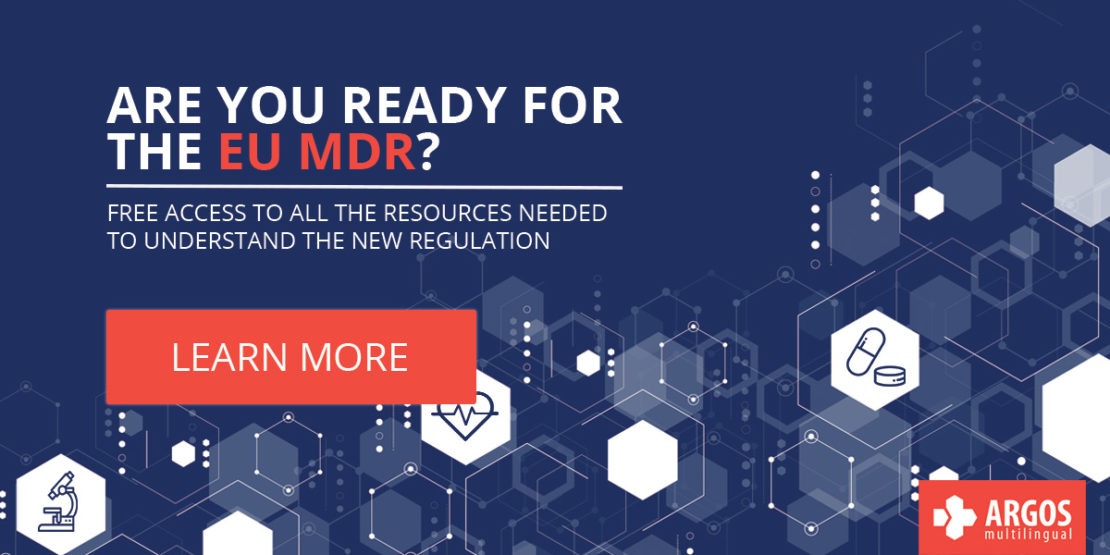The new EU Medical Device Regulations (MDR) will require close partnership with localization suppliers to ensure translation conformance.
While spring of 2020 might still seem the distant future, many medical device and in-vitro diagnostic manufacturers are already undergoing preparations for the two new European Union Medical Device Regulations (MDR) – Regulation (EU) 2017/745 and Regulation (EU) 2017/746 – which were adopted in 2017. Mapping out how and what the new regulations will impact and developing transition plans are a top priority right now for many manufacturers. (The European Commission postponed the MDR Deadline for one year, to 26 May 2021, to give medical device companies a chance to focus on the current COVID-19 pandemic)
So, what does this mean for MD and IVD companies trading in the European Union?
No matter whether you are headquartered in one of the states or simply exporting to one of the states, your business must meet the requirements addressed by these regulations, as well as any set out by individual states.
What about translations?
While Argos is able to provide general direction regarding language requirements for different markets, any decisions about which languages device information like IFU’s and labels – or documentation demonstrating conformity – will require translation into will be made by the Competent Authorities in each member state. In line with existing e-labelling directives, MDs and IVDs intended for professional use can continue to be supplied in an electronic format.
The new regulations focus on supply chain transparency and risk management, meaning that manufacturers will need to be able to show that their language service providers can demonstrate equally robust quality methodologies – likely through certifications such as ISO 13485:2016.
How will these regulations affect your Localization Program?
The regulations will not only affect technical documentation but also labels on medical devices and packaging. Similar to the US Food and Drug Administration UDI system, the EU regulations will require UDIs for each device, where the UDI will need to have a plain text version and a form compatible with automatic identification and data capture technology. Not only will labels and packaging need to be redesigned to capture these new elements, but also designs will need to accommodate language text expansion for translated versions.
It is vital to start talking to your language solutions provider to prepare a cost and time-effective solution across all affected content for all your target European markets and their corresponding languages.
Manufacturers will also need to demonstrate an effective Quality Management System (QMS) containing a risk-based approach to decision making and especially the monitoring of any tasks delegated to 3rd party suppliers. This will impact the translation and localization tasks assigned to your language solutions provider. The current ISO standard for Medical Devices – ISO 13485:2016 – is not explicitly required by either regulation, but as the recognized industry standard, it is generally thought to be both robust and compatible. Should any harmonization be required, your certification body is the best port-of-call in order to help ensure that your implementation of the ISO 13485 standard fits the new requirements.
The regulations do set out the requirements for the selection and effective control of suppliers. The ISO13485:2016 standard explains that:
“The processes required by ISO 13485:2016 that are applicable to the organization, but are not performed by the organization, are the responsibility of the organization and are accounted for in the organization’s quality management system by monitoring, maintaining, and controlling the processes.”
This means that a manufacturer can help to mitigate potential risks by ensuring that its supply chain is also ISO 13485 certified, including any language service providers used. Along with a small number of other LSP’s, Argos Multilingual is already certified to the standard.
To better understand the requirements of the European Union’s Medical Device Regulation and the impacts on language, visit www.mdreurope.com.
 Argos Multilingual
6 min. read
Argos Multilingual
6 min. read
The Role of Marketing Content Localization When Going Global The key to a successful business is understanding your customers. When seeking global expansion, all businesses are faced with the same prevailing question: How can we successfully enter and position our business, our brand and our products in this new market? It’s this question that has […]

 Argos Multilingual
7 min. read
Argos Multilingual
7 min. read
Information From ‘Behind the Scenes’ With In-Country Review Professional localization processes should incorporate a validation step whenever possible. The in‐country review (ICR) enables the end customer to provide input on company‐specific terminology, target audience, technical specifications of products in the target market, ensuring compliance with local regulations, as well as to share their profound product […]












